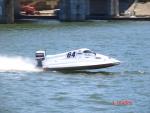
Originally Posted by
John (Taylor) Gabrowski

Sam LeBanco:
The graphite spray that Ted Coates used on the piston rings was different and he got it from mechanics at his commercial airport repair depot. The small can of graphite lube mix that was sold for fuel mixes specifically and different from the rings sprays was from "Wynnes" products, who also made a lot of other specialty lubricants to general sale to the public as well. He told me it was good for the OMC bushings still in the engine as well. He was also in the midst of converting his engines to more modern bearings and seals. After conversion he kept on using the Wynnes graphite lube in his fuel.
I thought the sparkplugs would foul on graphite being what it is but he always changed sparkplugs on the Elto and Johnson every heat anyway with clean ones so he never saw a problem by using his practices of changing plugs religiously to get excellent starting and running. For some reason he only changed sparkplugs on the Merc KG9 (Champion J4J) on the next race date but not at any other times between heats or even on a 2 day race weekend. He had no problems there either.
I was under the impression that the OMC 3 Holers being loop charged that they would run inherently cooler than their older deflector engines by virtue of the new technology but I am being informed that in either case that is just not so, be it a 35HP deflector or a 3 Holer looper. That for a ski/fishing based market that they are oversquare engines with way larger piston bores than crankshaft stroke making them high revers by their nature. Is there no way to make them transfer heat faster and tuned to run cooler? When it came to Merc/Mariner 3 Holer direct charged engines I thought my burn them to bits days were over and OMC a lot lot better?
People I know that are working on OMC 35 - 2 cylinder class C Modifieds are going to be very interested in your posts as there are 3 versions ports wise of these deflectors being constructed during their same years of production that from examining their innards as they put it have "racing written all over them"! They seriously want to boot some Yamato butt and are concerned about anything that can be done to make these engines heat managed, powerful and reliable given engines spec'd limitations for the class?
The nice thing about all the OMCs of yesteryear is that they are so so plentiful and so inexpensive to buy used albiet that they are all so heavy mainly from flywheel weight. Do these OMCs have to have such heavy flywheel systems to keep the whole motor stable or can they be made way smaller and lighter and still keep stock ignition parts going?
Sounds like asking for a lot of advice, yes but there are a lot out there who want to race and see racing spread through economies of scale, so OMC it is and just like Mercs here everything from the similar eras are so inexpensive for our sports use.



 Thanks:
Thanks:  Likes:
Likes: 
 Reply With Quote
Reply With Quote






Bookmarks